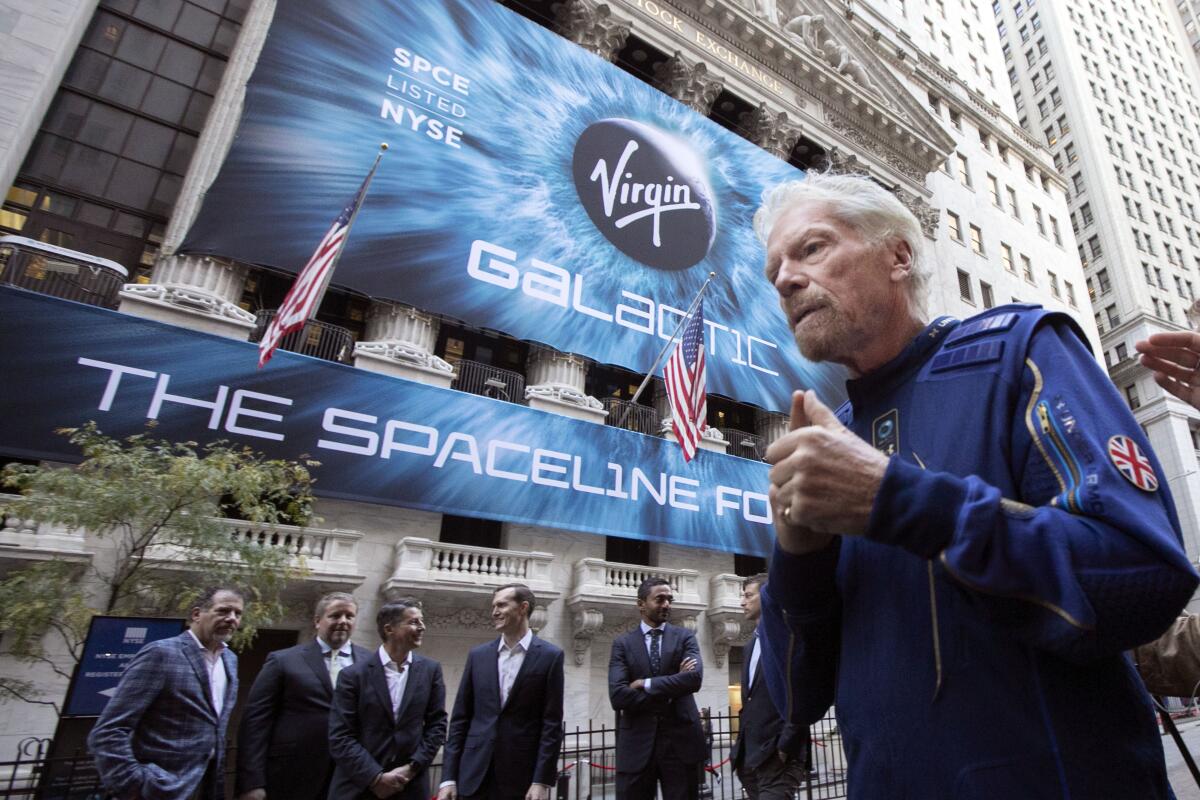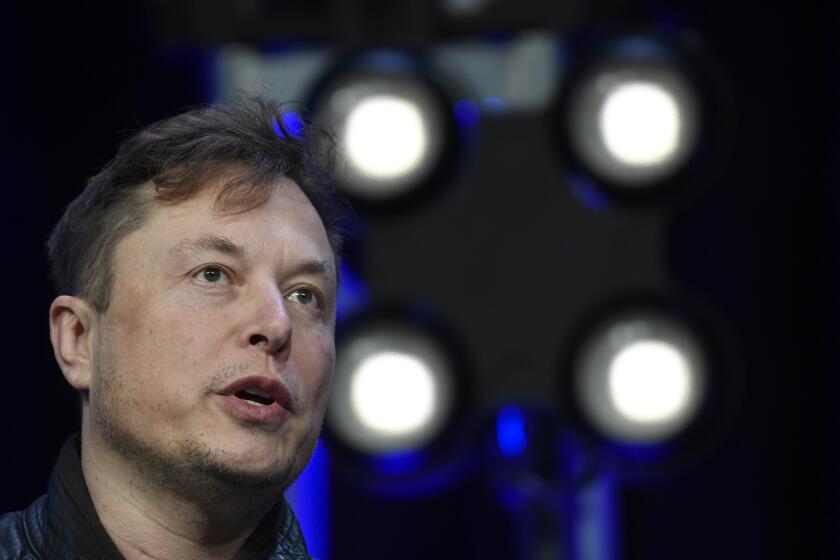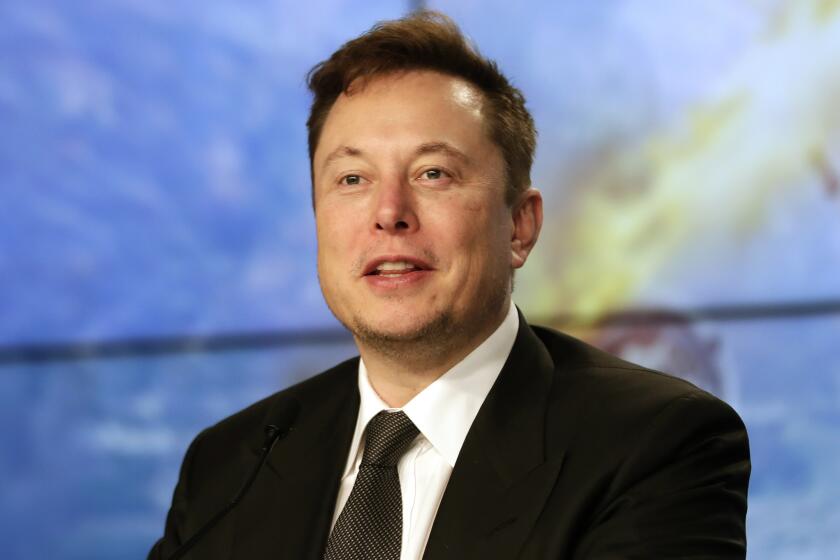Column: The Bezos-Branson-Musk space race is a huge waste of money and scientifically useless

- Share via
The big news on the spaceflight front last week was the announcement by billionaire Richard Branson that he would ride his Virgin Galactic spacecraft aloft on July 11, beating fellow billionaire Jeff Bezos to the edge of space by nine days.
Big news, that is, for anyone mourning the demise of the TV show “Lifestyles of the Rich and Famous,” which ran out its string more than 15 years ago.
For anyone else anchored here on planet Earth, the competition to be the first billionaire in space should mark a milestone in the towering vanity of the wealthy.
Everybody says that when you go to space, it changes you.
— Amazon founder Jeff Bezos, promoting his Blue Origin space tourism venture in 2017
Both billionaires place their ventures in the context of the need to test humans’ resilience to spaceflight, establish the safety of their craft, and expand humankind’s reach beyond our home planet.
That’s also a theme of the third billionaire engaged in this plutocrats’ space race, Elon Musk. He hasn’t been talking about taking a flight himself but does say the goal of his company, SpaceX, is to give humankind a foothold on other planets, specifically Mars.
Get the latest from Michael Hiltzik
Commentary on economics and more from a Pulitzer Prize winner.
You may occasionally receive promotional content from the Los Angeles Times.
Let’s promptly dispense with the notion that any of these flights will add anything to our scientific knowledge, unless it’s the establishment of a new metric for how long it takes for money to burn a hole in your pocket when you have more than you could possibly need.
Bezos, the founder of Amazon.com, told a news conference in 2017 that he was cashing in about $1 billion in Amazon stock every year to invest in his spaceflight company, Blue Origin. At his current net worth, he could continue that practice for another 200 years.
As has been the case virtually since the dawn of the Space Age, crewed spaceflight is all about public relations. I can say this from personal experience; as a schoolboy in the 1960s I knew the names and vital statistics of every one of the original seven Mercury astronauts, retailed as they were by Life magazine, which had reached an exclusive publicity deal with NASA.
The arrangement was the first step in a PR blitz that kept the space program at the forefront of American voters’ consciousness through successes and failures, right up to the moon landing of July 20, 1969. After that, anomie set in, broken now and then by upsurges in talk of further crewed voyages to the moon and a new quest to place astronauts on Mars.
The space shuttle, NASA’s follow-up to projects Mercury, Gemini and Apollo, never seemed to capture the public imagination as did those earlier programs aimed at landing on the moon.
The suborbital, up-and-then-back-down-again flights scheduled by Blue Origin will just barely reach the altitude generally regarded as the edge of space, 100 kilometers or about 62 miles; Virgin’s will fall about 12 miles short of that point.
As for advancing the science of spaceflight, it’s proper to note that the achievement of suborbital spaceflight was reached by the first launch of Project Mercury, with Alan Shepard aboard the Freedom 7 capsule — 60 years ago. (By then, of course, the Soviet Union had already sent cosmonaut Yuri Gagarin into orbit.)
Since then, the practical rationale for human spaceflight has only receded. As physicist Steven Weinberg observed way back in 2004, “NASA administrators, astronauts, aerospace contractors, and politicians typically find manned space flight just wonderful.”
That’s still the case — in 2017, the theme was picked up by Donald Trump, though it suffered the fate of so many other ventures of the Trump White House, subsumed into Trump’s usual miasma of boredom.
The Bezos and Branson flights are quite evidently designed to pump up the appeal of their companies’ nascent space tourism businesses.
Blue Origin says its ultimate goal is to support “millions of people ... living and working in space,” but its shorter-term goal is to ferry passengers on flights of 10 minutes or so, during which they can experience about three minutes of weightlessness and perhaps get an inspiring glimpse of Earth from afar.
“Everybody says that when you go to space, it changes you,” Bezos said at that 2017 event. “All the astronauts come back with stories like that. It’s very emotional to see this Earth, to see the thin limit of the atmosphere.”
ProPublica’s tax investigation shows why billionaires should be taxed on their wealth.
The glamour of life in space has been part of popular culture for the better part of a century. In recent decades it has been fostered by “2001: A Space Odyssey,” “Star Trek” and “Star Wars,” and “The Martian.”
The real danger of thrill-seeking via spaceship is that it distracts from problems here on the ground. It’s become a bit of a cliche to say that we should be spending more on the fight against global warming, but NASA projects have contributed immeasurably to Earth science — at least until congressional conservatives steered the agency away from those projects so it could spend more on interplanetary exploration.
Almost every goal cited for crewed spaceflight, Weinberg observed, could be performed today more efficiently and more cheaply by uncrewed flights.
The most spectacular gains in knowledge about Mars, for instance, have been provided by by robots. They include NASA’s Perseverance rover, which landed on the red planet on Feb. 18, about seven months after its uncrewed launch, and Curiosity, which landed in 2012 and is still sending photographs our way. They were preceded by Spirit and Opportunity, which were launched in 2003 and landed the following year.
Those projects cost a mere fraction of what it would have taken to send humans to Mars, even if that were technically possible. The reason is that once humans are aboard, their safety becomes the paramount concern of the mission, driving up its cost exponentially.
Elon Musk’s burst of charitable giving is less than a tenth of a penny per dollar of his vast fortune.
As I observed after Trump’s Feb. 28, 2017, address to Congress in which he hinted at a resumption of crewed space exploration, the public obviously considers human participants to be indispensable, so much so that a loss of life can almost destroy a space program, as happened with the space shuttle program after two human catastrophes.
One example of the wastefulness of crewed missions is the Hubble Space Telescope, which was placed into orbit in 1990 by the space shuttle. But the Hubble could just as easily have been launched by an uncrewed mission — indeed, as Riccardo Giacconi, the former director of the Space Telescope Science Institute, estimated, doing so would have allowed seven Hubbles to be launched for the same price as the single shuttle-launched telescope.
Crewed space missions are customarily justified by the advances in science and technological know-how thrown off by the space race. That notion has an enduring allure. Two Trump advisors writing just before the 2016 election promoted the notion of renewed crewed exploration by citing the “brilliant returns for our economy, our security, and our sense of national destiny” produced by past investments in space exploration.
They didn’t mention any specific economic returns, brilliant or otherwise, perhaps because they couldn’t identify any that would not have been produced by an uncrewed moon program. (One of the authors was Peter Navarro, then of UC Irvine, whose later promotion of a useless remedy for COVID-19 should put his expertise in perspective.)
The vanity projects of the billionaire astronauts are endowed with a science-y veneer. Larry Connor, an Ohio apartment tycoon who put up a reported $55 million for an eight-day stay on the International Space Station, ferried there by Musk’s SpaceX, told the Washington Post he’s “collaborating with the Mayo Clinic and Cleveland Clinic on research projects” and will give classes on his experience to students at a Dayton charter school. (Connor’s firm says the price tag reported by the Post is incorrect, but won’t divulge the real figure.)
Perhaps these projects will have genuine scientific value. If so, however, they would be conducted by experienced scientists, not a 71-year-old Dayton real estate man. More likely, they’ll be like other science projects sent aloft on the space shuttle, which Weinberg acerbically dismissed as having “the flavor of projects done for a high school science talent contest.”
What about the prospects of humans colonizing or even conducting research on Mars? This has the flavor of popular science fiction. The truth is that Mars is a place irredeemably hostile to human life. The planet’s atmosphere is unbreathably thin and lacks a global magnetic field, which means that human residents would be inundated with cosmic and UV rays.
Space exploration aficionados experienced the thrill of anticipation in the hours before President Trump’s speech Tuesday night, with advance word that he was going to call for a return to the human exploration of space.
Its surface temperatures fall as low as minus 80 degrees Fahrenheit, a level approaching that of Antarctica. At the poles, temperatures can reach as low as minus 200 degrees F. The planet’s gravitational pull is about one-third that of Earth.
Mars aficionados like Musk counter these facts with hand-waving. “It is a little cold, but we can warm it up,” SpaceX says. “Gravity on Mars is about 38% of that of Earth, so you would be able to lift heavy things and bound around.” Never mind that low gravity, as experienced by astronauts on long missions, wreaks havoc with human biological systems including the heart, bones and muscles.
One underlying theme of space travel enthusiasts like Musk and Bezos is that humans need a Plan B. The assumption is we’ve screwed up Earth so badly that there’s little point in trying to fix what we broke. They have the wrong end of the stick. Answers to global warming and disease are still much more accessible than fleeing Earth for space. The dream of interplanetary travel and colonization is the dream of schoolchildren, and it’s time that the billionaires grew up.
More to Read
Get the latest from Michael Hiltzik
Commentary on economics and more from a Pulitzer Prize winner.
You may occasionally receive promotional content from the Los Angeles Times.













